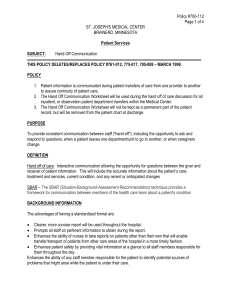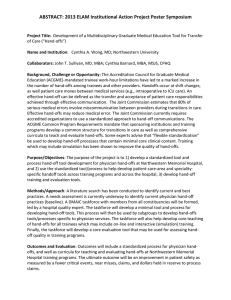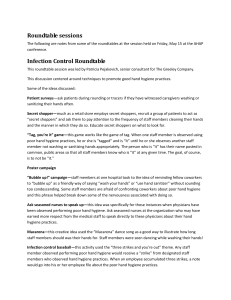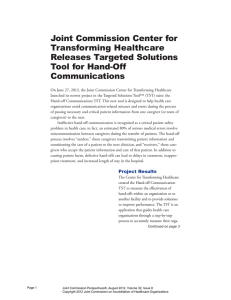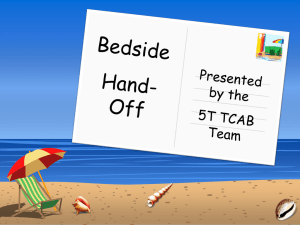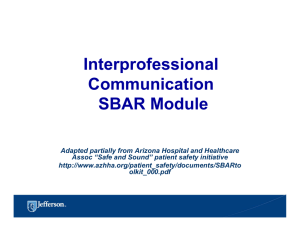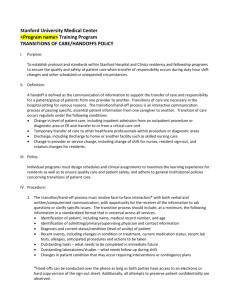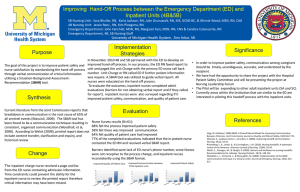Issues up close (Jan'14) - American Nurses Association
advertisement
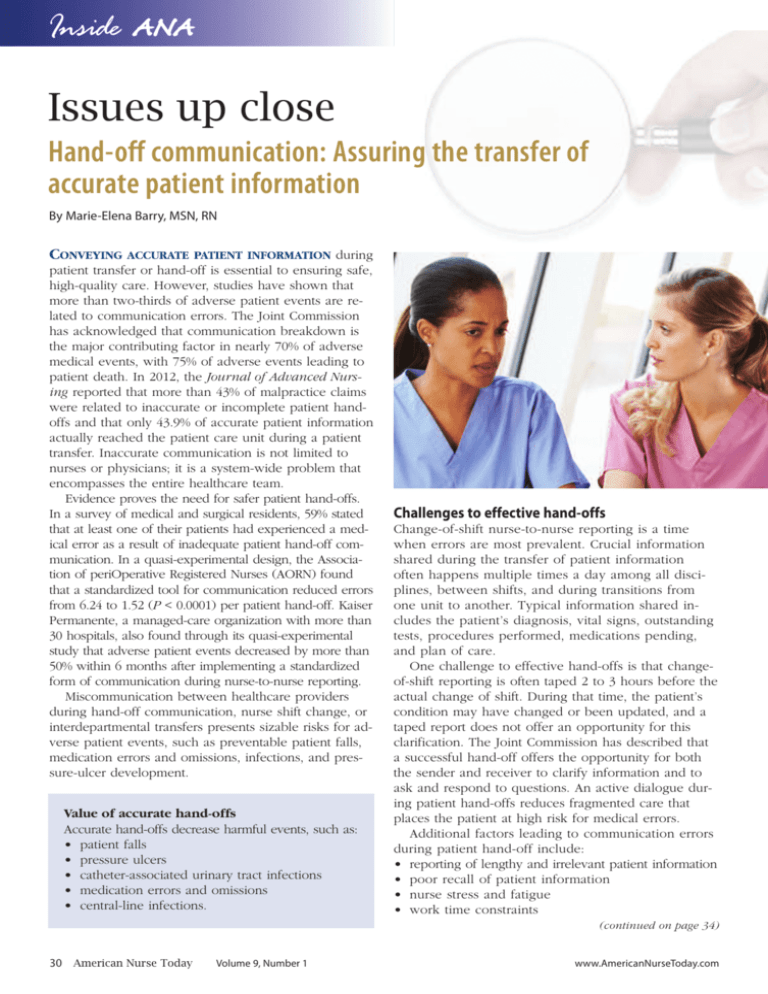
Inside ANA Issues up close Hand-off communication: Assuring the transfer of accurate patient information By Marie-Elena Barry, MSN, RN CONVEYING ACCURATE PATIENT INFORMATION during patient transfer or hand-off is essential to ensuring safe, high-quality care. However, studies have shown that more than two-thirds of adverse patient events are related to communication errors. The Joint Commission has acknowledged that communication breakdown is the major contributing factor in nearly 70% of adverse medical events, with 75% of adverse events leading to patient death. In 2012, the Journal of Advanced Nursing reported that more than 43% of malpractice claims were related to inaccurate or incomplete patient handoffs and that only 43.9% of accurate patient information actually reached the patient care unit during a patient transfer. Inaccurate communication is not limited to nurses or physicians; it is a system-wide problem that encompasses the entire healthcare team. Evidence proves the need for safer patient hand-offs. In a survey of medical and surgical residents, 59% stated that at least one of their patients had experienced a medical error as a result of inadequate patient hand-off communication. In a quasi-experimental design, the Association of periOperative Registered Nurses (AORN) found that a standardized tool for communication reduced errors from 6.24 to 1.52 (P < 0.0001) per patient hand-off. Kaiser Permanente, a managed-care organization with more than 30 hospitals, also found through its quasi-experimental study that adverse patient events decreased by more than 50% within 6 months after implementing a standardized form of communication during nurse-to-nurse reporting. Miscommunication between healthcare providers during hand-off communication, nurse shift change, or interdepartmental transfers presents sizable risks for adverse patient events, such as preventable patient falls, medication errors and omissions, infections, and pressure-ulcer development. Value of accurate hand-offs Accurate hand-offs decrease harmful events, such as: • patient falls • pressure ulcers • catheter-associated urinary tract infections • medication errors and omissions • central-line infections. Challenges to effective hand-offs Change-of-shift nurse-to-nurse reporting is a time when errors are most prevalent. Crucial information shared during the transfer of patient information often happens multiple times a day among all disciplines, between shifts, and during transitions from one unit to another. Typical information shared includes the patient’s diagnosis, vital signs, outstanding tests, procedures performed, medications pending, and plan of care. One challenge to effective hand-offs is that changeof-shift reporting is often taped 2 to 3 hours before the actual change of shift. During that time, the patient’s condition may have changed or been updated, and a taped report does not offer an opportunity for this clarification. The Joint Commission has described that a successful hand-off offers the opportunity for both the sender and receiver to clarify information and to ask and respond to questions. An active dialogue during patient hand-offs reduces fragmented care that places the patient at high risk for medical errors. Additional factors leading to communication errors during patient hand-off include: • reporting of lengthy and irrelevant patient information • poor recall of patient information • nurse stress and fatigue • work time constraints (continued on page 34) 30 American Nurse Today Volume 9, Number 1 www.AmericanNurseToday.com SBAR and I PASS THE BATON (continued from page 30) • frequent or repeated interruptions by the patient or other members of the healthcare team. Another issue complicating the communication process is that individual styles of communication vary and are influenced by multiple factors, such as generational differences, ethnicity, gender, educational level, and cultural background. The Institute of Medicine’s 2003 report “Keeping Patients Safe: Transforming the Work Environment of Nurses” recommends that to improve the transfer of patient information, healthcare facilities should implement innovative strategies to improve the quality of patient hand-off communication by limiting avoidable interruptions and distractions. The SBAR format consists of four categories: Situation (S), Background, (B), Assessment (A), and Recommendation (R). This standardized communication tool provides a framework for consistent communication and has been shown in multiple studies to effectively communicate patient information and reduce adverse patient events. S: Situation Complaint, diagnosis, treatment plan, and patient’s wants and needs B: Background Vital signs, mental and code status, list of medications, and laboratory results A: Assessment Current provider’s assessment of the situation R: Recommendation Identify pending lab results, what needs to be done in the next few hours, and other care recommendations Institute for Healthcare Improvement. SBAR Toolkit. 2013. www.ihi.org/knowledge/Pages/Tools/SBARToolkit.aspx. TeamSTEPPS® uses the mnemonic “I PASS the BATON” as a tool to improve communication during patient handoffs and care transitions. (See below.) I Introduction Individuals involved in handoff identify themselves, their roles, and jobs. P Patient Name, other identifiers, age, sex, location Tools for successful hand-offs A Assessment Present chief complaint, vital signs, symptoms, and Research shows that implementing diagnosis a standardized communication tool reduces the risk of transmitting inS Situation Current status and circumstances, including code status, level of certainty or uncertainty, recent accurate and incomplete informachanges, and response to treatment tion. Organizations that have implemented a standardized hand-off tool S Safety concerns Critical lab values and reports, socioeconomic have acknowledged significant defactors, allergies, and alerts (such as risk for falls) creases in patient falls during nursB Background Comorbidities, past medical history, current ing change of shift. For example, medications two strategies have helped improve hand-off communication—SBAR and A Action Detail what actions were taken or are required and I PASS the BATON. (See SBAR and provide a brief rationale for those actions. I PASS the BATON.) T Timing Prioritization of actions Sharing patient information during a handoff should occur face to O Ownership Which team member is responsible? face in a quiet environment away (Nurse, physician) from direct exposure to patients and visitors and with minimal interN Next What is expected to happen? What is the plan of care? ruptions. Both verbal and written Agency for Healthcare Research and Quality. TeamSTEPPS Fundamentals Course: Module 6. Team Structure. communication have been shown to Classroom Slides. 2008. www.ahrq.gov/teamsteppstools/instructor/fundamentals/module6/slcommunication.htm. minimize communication handoff errors. Face-to-face communication allows the person who is receiving the patient to ask formation and communication errors. Patient hand-off questions to clarify the plan of care. Boston Hospital communication is often inconsistent throughout System medical errors were reduced more than 40% health systems and has been identified as a contributafter implementation of a “handoff bundle.” A handing factor leading to adverse patient events. When off bundle is composed of staff team training, implemented, a standardized communication tool has mnemonic training, and a computer-aided tool that been shown to effectively decrease adverse patient utilizes a patient’s medical record and assists with the events. O generation of up-to-date patient information. Marie-Elena Barry is a senior policy analyst in Nursing Practice & Policy at Change-of-shift reporting and patient transitions ANA. are times when there is increased potential for misin34 American Nurse Today Volume 9, Number 1 www.AmericanNurseToday.com

